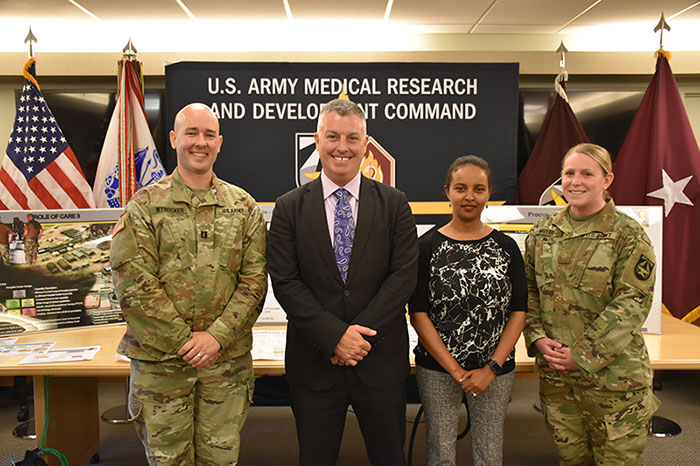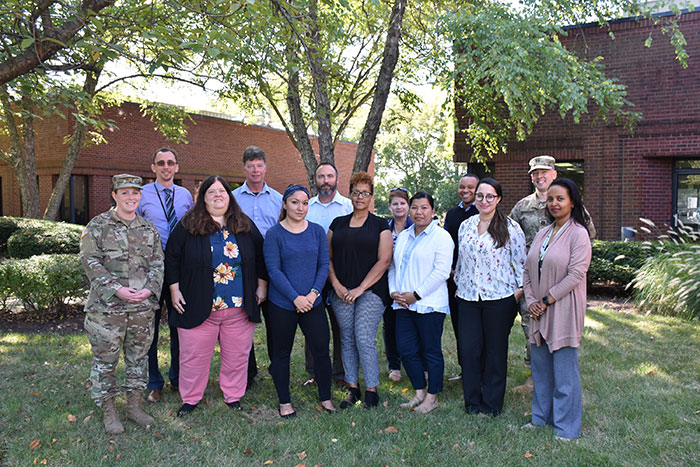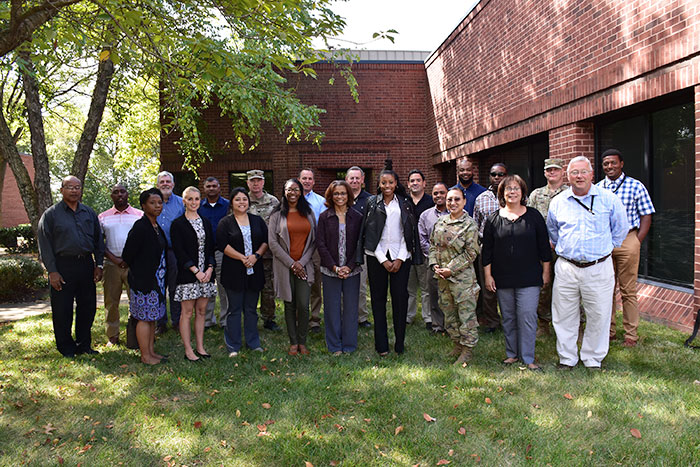USAMMDA Team Spotlight: Warfighter Deployed Medical Systems Project Management Office

As the newest project management office of the U.S. Army Medical Materiel Development Activity, the Warfighter Deployed Medical Systems Project Management Office maintains a mission to develop, deliver and sustain deployable medical capabilities for the Warfighter. Composed of two product management offices, Medical Device Assemblage Management and Medical Modernization, the WDMS PMO is considered the focal point for medical materiel lifecycle management within the Army.
In this new installment of USAMMDA's spotlight series, our public affairs team sat down with Dr. Tyler Bennett, project manager of the WDMS PMO, to discuss the ongoing projects and success stories involving his team. Bennett has been with USAMMDA since earlier this year, when his team moved under the organization, transferring from the U.S. Army Medical Materiel Agency in an Army realignment effort designed to streamline its workforce.
The WDMS PMO plays the central role in the equipping and sustainment of critical devices for the nation's military forces, which helps to keep our Warfighters ready for the fight. Among its numerous responsibilities, the WDMS PMO maintains the medical materiel database to ensure standardization and the availability of materiel, while it also provides continuous "technical watch" to rapidly replace obsolete medical devices to help ensure a minimal or zero gap in critical field capability. Without question, the combined efforts of its team members help to support the USAMMDA mission of developing and delivering important medical capabilities to protect, treat and sustain the health of our nation's Warfighters, and Bennett remains both supportive and proud of his entire staff of dedicated professionals.
PAO: Please describe the mission of the WDMS PMO.

TB: Warfighter Deployed Medical Systems is one of the final steps in the acquisition process. We procure and field the things that come out of the U.S. Army Medical Research and Development Command's Decision Gate system, and out of the Milestone process. We execute all of the medical procurement dollars. If this PMO did not exist, the deployed medics would not have the critical medical equipment necessary to provide lifesaving diagnosis and treatment of injured Warfighters.
PAO: What do you like most about your job?
TB: What I like most about my job is that we interact directly with the end-users – those Warfighters who actually use our devices. We get feedback almost daily on items such as ventilators, vital signs monitors – I received a message recently regarding a suction apparatus. So, when there is an issue with maintaining or using a device, or training on using it, we get phone calls directly from the field. I really like the daily interaction with the folks using these devices.
We recently fielded a concern from users in a deployed environment because of an issue with their ventilators that were failing. In fact, they had nine failures over the last year, and the user told me, "This is so serious, that if I didn't have a backup ventilator that worked, the patient would have died – so we need to get these things replaced immediately."
In response to this, we were successful in obtaining additional funding, to replace ventilators, and these are on the way right now. And we received a Thank You note from them just yesterday. So what we do here directly impacts patient care in the deployed setting, and that's really the most rewarding part of my job.
PAO: Please describe what the WDMS PMO does on a daily basis.
TB: We work directly with both users and developers to ensure that what makes it to the field is what the users want. Our PMO is divided into two groups right now. We have one team, the Medical Device Assemblage Management product management office, that focuses directly on the things that are already out there. We manage 207 line item-numbered pieces of equipment that are currently deployed, and they're fielded in 140 Sets, Kits and Outfits, or SKOs. The MDAM team manages the day-to-day activities of these items. So if there is a maintenance issue, or if a Unit needs a specific item to fill out its SKO, those are the folks that do the analysis for this, and the procurement.

Of these 207 items, there are roughly 30 that are no longer procurable right now, so we also have a Modernization product management office, and its focus is placed on modernizing the equipment (to ensure functionality). The suction apparatus I mentioned earlier is one of our recent successes. The company no longer made the item, so we had to source a new solution, and then get that fielded along with the other equipment that supports it. Our Modernization team also manages the major force design updates, like the Combat Support Hospital conversion. They have a smaller team within their office that focuses solely on doing this for the force. So, between the day-to-day activities of the MDAM team, and the modernization and future activities managed by the Modernization office, these two groups help us get the right product to the right Warfighter at the right time!
PAO: What are your thoughts on your team's move from USAMMA to USAMMDA?
TB: It's been very exciting, actually – so, as the Army has moved and developed, it has stood up the Army Futures Command, and it's one of the biggest changes the Army has undergone in the last several decades. As part of this move, Army Medical was affected, and there was a change at the organization I used to work at, the U.S. Army Medical Materiel Agency, which remained under the Army Materiel Command to focus on the sustainment of the medical equipment. While we are responsible for the entire lifecycle of medical devices, my team's primary focus is on the upfront procurement and fielding. So our group moved over to USAMMDA to be more closely tied to the acquisition PMOs in the organization. It was really a great move for our team, as we're more closely intertwined with the people doing the development. It's a much better alignment of our mission space, as it allows us to work with the other PMOs, to meet our shared objectives. At the same time, however, we still maintain a very strong link to USAMMA, to make sure the sustainment of these items occurs when it needs to after the products are fielded.
PAO: Can you share some recent success stories involving your WDMS PMO team?
TB: Army Maj. Janessa Moyer is the current product manager for our Modernization group, and she's been very successful in bringing the other Services together for joint procurements. Right now, there is really no forcing function to bring the Army, Navy and Air Force together to the table. It's more a coalition of the willing, but Maj. Moyer has done an excellent job of bringing all of the Services together for procurement actions, and a great example of this is the CT [computed tomography] scanner. She led a joint team, to include the Air Force and Navy, to put out a solicitation for the new CT scanner of the future, and they awarded the contract a few months ago. It's currently being integrated by a commercial partner in Oregon, with delivery expected in late November.
By going with this joint procurement, we receive a volume discount, so we save a lot in procurement costs. We also save a lot in sustainment costs because now the other Services will be buying the same parts, which will keep the production base alive longer – this will allow us to sustain these items longer in the field. In addition, we also did the same thing with the vital signs monitor, which was a joint procurement, driving down the costs significantly, which saves taxpayer dollars. Right now, most of the 30 devices in the Modernization office are joint Service efforts, and I think this is a great success story for all of the Services.
PAO: Can you describe the WDMS PMO's role in product development?
TB: Well, we work at the very end of the development stage, as we work to modernize items that already have been fielded, so right around Milestone C. For those things that are earlier in the development process, or even in the Science & Technology stage, our team provides subject matter expertise on integrated product teams for each device. So, for everything that is in Decision Gate, going through the acquisition process, we're at the table with the program managers to ensure that factors such as procurability and sustainability are looked at as early as possible in the acquisition process.
One of the other things we bring to the table, which I really appreciate, is that we have clinicians – active-duty Army clinicians – that rotate through our team every two to three years. We have a nurse consultant, a lab consultant, a pharmacy consultant, and these folks bring incredible expertise to our group. Many of them have been deployed, or may have recently come off of a deployment, so it's an excellent resource for the rest of our team, many of whom may have never been deployed or may not understand how a particular device can be used in a deployed environment. So, having this expertise on our team, and providing support to the IPTs is extremely valuable, and it's something I haven't experienced in any of my other program management positions.
PAO: What is the best part of your job as the WDMS PMO project manager?
TB: The team is what makes me the most proud – the way they're excited to come to work, and to work on their devices, because they know that what they do, on any given day, has a direct impact on the Warfighter. And that has a certain amount of energy and passion that goes with it. It just makes you want to show up for work in the morning – it's very exciting to work with this group of people.
PAO: What are your thoughts on the future of the WDMS PMO?
TB: As we move forward, we expect that significant change will continue to occur, as the Army continues to change. I think the structure we've formed at USAMMDA, and the great teams we've built here will remain in a good position to weather whatever the next change may be that comes down the road.
To view the USAMMDA PAO interview with Dr. Tyler Bennett, click on the following link:
USAMMDA PAO interview with Dr. Tyler Bennett













